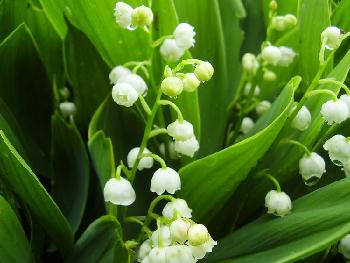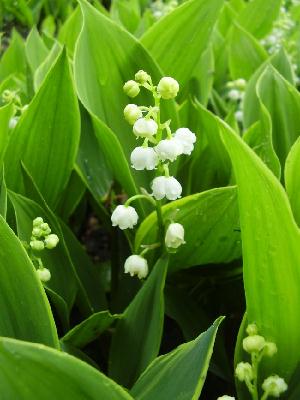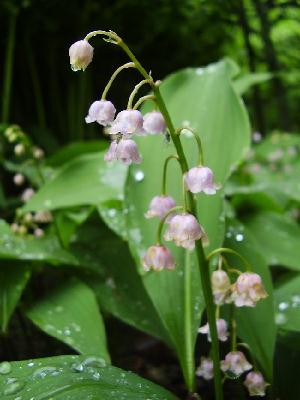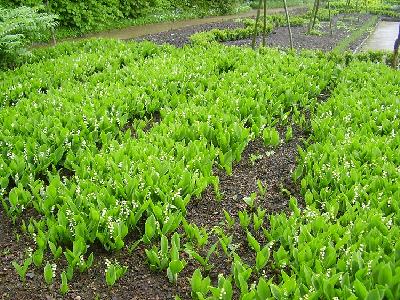Lily Of The Valley
Convallaria majalis
by Debs Cook

Convallaria majalis
Sorting through some photographs taken in May last year, I discovered some lily-of-the-valley pictures taken whilst on one of our regular trips to Hardwick Hall in Derbyshire. These reminded me of the scent, which, in turn reminded me of my Nanna. Lily of the valley has one of those smells that, to this day, raises a smile and fond memories of my Nanna, taking me back to my childhood.
I recall telling her she smelt pretty and asking her why she liked the smell. She said it was her 'lucky' perfume because she was wearing it when she met my Grandad.
When Nanna died, we found a batch of letters she had sent to Grandad whilst he was away fighting in the war. They were tied with a pretty ribbon, with a long faded and dried sprig of lily of the valley tucked underneath. Were the flowers a gift from my Grandad or did Nanna put them there to remind her of a precious memory? I guess I'll never know, but the lily of the valley was more than a 'lucky perfume' to her.
All this reminiscing is wonderful, but it occurred to me that, beyond the scent memories, lily of the valley was (and still is) used medicinally to treat heart conditions. The action of lily of the valley is released slowly and steadily unlike digitalis which is released all at once, making it safer than digitalis. But it is still a deadly and toxic plant if used incorrectly and so must be administered by a qualified herbal practitioner.
I thought it was time to learn more about this old herb and to share this with you. It is grown as a spring bulb in most gardens today but is not recognised as a herb by most.
History & Folklore

'Hardwick Hall'
Lily of the valley has been used since the middle ages when they were popular in bridal bouquets to symbolise purity and modesty. It became a favourite flower of the Elizabethan's who use it in tussie mussies and nose gays to help perfume the air. There is also mention in some texts of the flowers being used to make a drink that became known as 'Aqua Aurea' that was believed to help boost the memory as well as treat heart conditions.
Apollo is said to have given the lily of the valley as a gift to Aesculapius, the Greek god of healing.
During the First World War it was used to treat victims of mustard gas although I cannot find out why. However, one of the effects of mustard gas is to blister and burn the skin, and an ointment made from the roots of lily of the valley can be used to treat burns. I'm therefore assuming it was used topically to treat burns. If anybody knows exactly what it was used for, please let me know and we can edit this section to reflect the true use?
The Latin name for this pretty herb, convallaria majalis, derives from the Latin convallis 'valley' and majalis 'May-flowering'. It is also known as May lily, Our Lady's Tears, Lily Constancy, Ladder To Heaven and Convall Lily. It is a member of the family Ruscaceae along with Solomon's Seal (Polygonatum multiflorum) and Butcher's Broom (Ruscus aculeatus).
Lily of the valley has been associated with May for centuries. In France, it has been used to bring good luck since the early renaissance and it is one of the flowers associated with the Pagan festival of Beltane which also occurs on May 1st. Old folk tales claim that Lily of the valley protects your garden from evil spirits. Carrying a posy of the flowers is said to improve your memory. The flowers were said to cheer the heart and lift the spirits of all those in their vicinity.
While researching this article, I've found this herb associated with luck, happiness, protection, purity, modesty, humility and the 'return of happiness'. This last point may have been why my Grandad's war letters contained preserved lily of the valley.
Description

'Rosea'
Lily of the valley flowers are most commonly white, but there are also pink varieties and those with variegated leaves. It is a British native, that can be found growing in woods as well as gardens across the UK, and can also be found in Asia and Europe. Classed as a herbaceous perennial, lily of the valley forms 'colonies' as can be seen in the final photograph to be found at the end of this article. They do this by means of underground stems called rhizomes or 'pips' which spread prolifically. The rhizomes send up numerous stems each Spring. Each stem grows to 15-30 cm tall, with two leaves 10-25 cm long, and a raceme of 5-15 flowers on the top of the stem. The flowers are bell-shaped, 5-10 mm in diameter, and very sweetly scented. Flowering is in late spring, most often May, but in mild winters they've been noted to flower as early as March!
They're more likely to be found featured in garden publications as a flower than a herb these days. As they don't have many herbal uses by the lay person they seem to have fallen off the herb radar and been consigned to the garden plant catalogues.
One place that you can see them growing as a herb is at Hardwick Hall which, not surprisingly, is where the variety 'Hardwick Hall' comes from. I contacted Ian Hunt, the Head Gardener at Hardwick, to enquire about the age of the variety and he sent me the following quote from the first edition of Gardens of the National Trust, by Graham Stuart Thomas, Hardwick's' first Gardens adviser:
'Nobody knows whence came 'Hardwick Hall' Lily of the valley; it is distinguished by it's large bells and broad foliage which has a markedly pale edge'.
So it's a bit of a mystery as nobody knows where it came from, but Ian has promised to dig around and let me know what he finds out. It really is a delightful variety that smells heavenly.
Growing
Lily of the Valley is fairly easy to grow. They'll adapt to almost any soil conditions but prefer the soil to be on the moist side but well-drained, sand rich and with lots of organic matter.

Plant the bulbs in the autumn, preferably in late September. The rootlets are called "pips" for some reason and these can be planted either in the spring or autumn.
The can be divided in the autumn. Plant the divisions about 15 - 25cm apart and about 7-10cm in depth in partial or full shade. Make sure you firm the soil around them well after planting.
Lily of the valley can be slow to establish but once established they can take over the garden. In my experience they take 3 - 5 years to come to their full glory depending on where they're planted and the soil conditions. The joy of seeing your first lily flowers from the bulbs you planted is worth the wait as Sarah Head from the forum discovered. I went to visit her garden and she took me to the spot where she was growing some and we spotted her first flowers of the year!
Medicinal Use
Lily of the valley is only used by qualified herbalists these days. It is another of those herbs that is no longer considered safe to be self administered by the lay person. In the 16th century, herbalist John Gerard, advocated the use of the herb for those who had "dumb palsie" (known as Bell's Palsy these days, a condition which affects the facial muscles giving them a 'drooping' look) and for those who "had fallen into apoplexy". He also said it was good for gout and the heart. The leaves and flowers contain cardiac glycosides, including convallatoxin, which have been used in medicine for centuries. It also contains convallamarin, which has effects similar to digitalis, so medieval herbalists used it as a substitute for foxglove.
